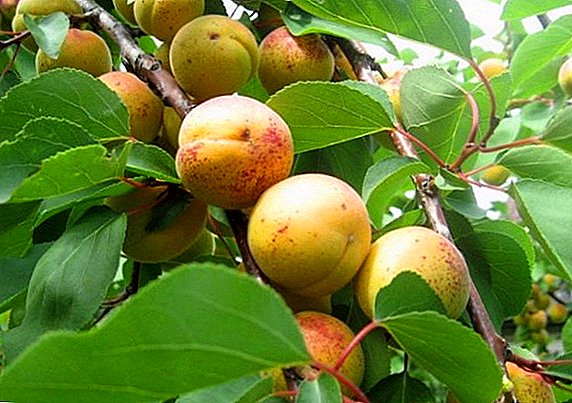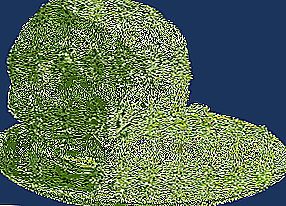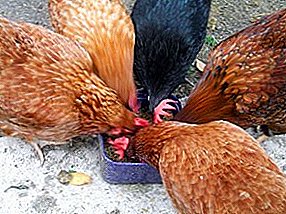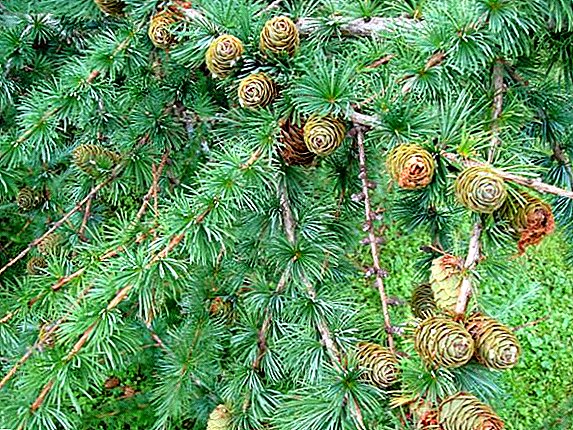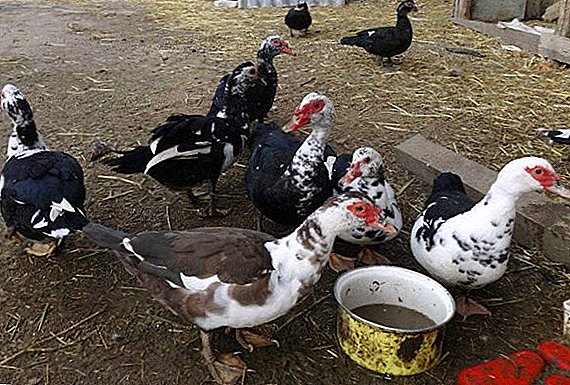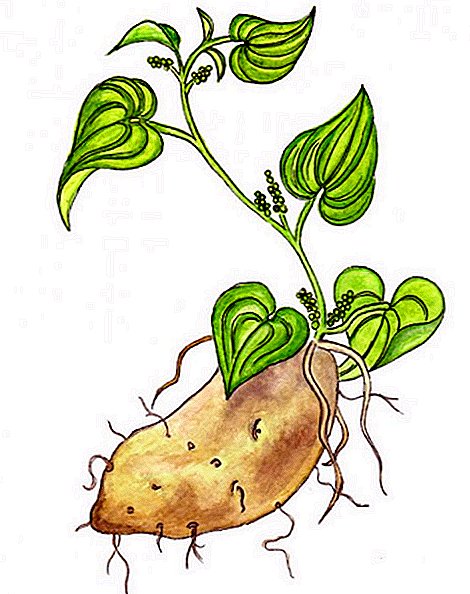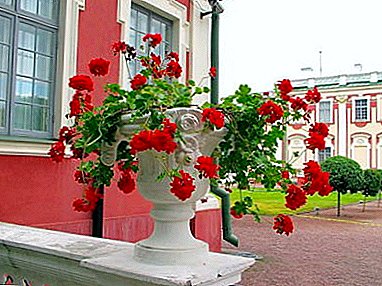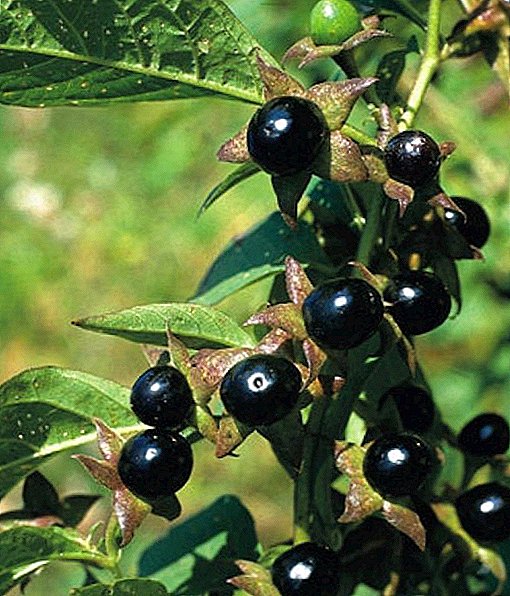 This beautiful plant prefers to grow in small plantings or singly. All the mysterious history of its existence is accompanied by rumors and fictions, truth and lies, great benefits and great harm. This is about belladonna, or belles.
This beautiful plant prefers to grow in small plantings or singly. All the mysterious history of its existence is accompanied by rumors and fictions, truth and lies, great benefits and great harm. This is about belladonna, or belles.
Description
About this plant there are many legends and tales that are united by one thing: the plant is toxic, but in small doses can be treated. Belladonna - means "beauty." And it is not surprising - the aristocrats of Ancient Rome used her tincture to widen the pupils and make the look more expressive, or put it on the cheeks for a "natural" blush.
We recommend that you familiarize yourself with the 10th popular useful plants.
And its mystical history began in ancient Greece. According to legend, three Moira - the goddess of fate - were responsible for the duration of the thread of a person’s life. The eldest of them, Atropa, cut her mercilessly. So in one name incompatible concepts were connected: Atropa belladonna - "death" and "beauty."  This perennial plant has always been shrouded in mystery, it was considered a potion of witches and witches, the magic drug of medicine men. And the series of its names only confirms this unkind glory - rabid, wolfberry, belladonna, bloody berry, German, mad cherry, sleepy potion, sleepy stupor.
This perennial plant has always been shrouded in mystery, it was considered a potion of witches and witches, the magic drug of medicine men. And the series of its names only confirms this unkind glory - rabid, wolfberry, belladonna, bloody berry, German, mad cherry, sleepy potion, sleepy stupor.
Externally, it is a bush with a green stem (sometimes it has a purple hue), its height is 1-1.5 m, a very powerful root system, leaves are green, pointed shape, flowers are large (about 3 cm), look like elongated purple bells colors. The berries are black, inside divided into two halves, filled with seeds, juice, like ink.
Outwardly, they resemble small cherries. Belladonna belongs to the nightshade family.
It blooms from May to July, the berries ripen in September. It is then that they are collected when they become fully mature. Belladonna is poisonous, not only the berries, but all parts of the plant - the stem, roots, leaves and even flowers. There are cases of honey poisoning from belladonna.
Read more about dangerous poisonous plants.
Chemical composition
The main component of the belladonna component is tropane alkaloids (atropine, atropamine, scopolamine, hyoscyamine, belladonin).  Their content may be:
Their content may be:
- in the leaves - 0,30-1,10%;
- in the stems - 0,11-1,15%;
- in flowers - 0,30-0,53%;
- in the fruit - 0,16-0,35%;
- in the roots - 0,21-1,10%.
If poisoned
Belladonna, or belladonna, is easy to confuse with wild cherry. True, her taste is sweet, without sourness. But the consequences can be fatal: severe poisoning occurs if the child eats only 2-3 berries, and an adult - 10-20 berries.
The poisonous plants that have medicinal properties are also referred to as: a soft bedstraw, an elderberry, a cockle, a hogweed, a black root, a milkweed, a cypress tree, a burning bush, a crested bird, an acornite, a wolf, a European cone, and a trefoil.
Therefore, the advice to not eat unknown berries is more relevant than ever. Especially since the belladonna juice, remaining on the hands, can also be harmful to yourself by touching the face, mouth or eyes. 
Symptoms of poisoning
Since the whole plant is poisonous, you can poison yourself with any part of it. Most often, poisoning occurs when eating berries. You can get poisoned by using belladonna as part of tinctures, ointments, decoctions, or by using drugs, of which belladonna is a part. The parasympathetic and central nervous system is affected.
Signs begin to appear 15-20 minutes after ingestion:
- throat spasm;
- tight breathing;
- mucous membranes of the mouth dry;
- loss of voice;
- pupils grow and stop responding to light;
- high temperature;
- desire to drink, nausea, vomiting;
- a significant decrease in urine waste and a decrease in bowel activity;
- low pressure;
- the number of heartbeats increases to 140-150 per minute;
- dyspnea;
- the color of the lips and mucous membranes is blue;
- loss of orientation in space;
- motor restlessness, convulsions, memory loss. Then the person falls into a sleepy state, a lethargy appears;
- confusion, hallucinations. Poisoning is like an acute psychosis.

Did you know? Belladonna is in the TOP-10 plant toxins, ranking 8th in this list.
First aid
The first thing to do is call an ambulance. But you can independently help the patient:
- Wash the stomach - a weak solution of potassium permanganate, boiled water (or slightly salted water solution). The procedure is best carried out several times.
- You can offer the victim activated carbon at the rate of 1 tablet per 10 kg of weight. Coal is better to grind and mix with water. This solution needs to be drunk.
- With a significant increase in temperature, wet sheets are recommended for wrapping and wiping with wet towels. Ice can be applied to the head.
- With strong arousal, Corvalol or Valocordin is indicated.
Treatment of poisoning
Appeal to doctors necessarily. After all, only a doctor can assess the condition of the patient (it can only look like a lung), determine the treatment, its urgency and volume.
In the hospital, it is necessary to wash the stomach, administer an antidote (1% solution of Pilocarpine, a solution of 0.05% Prozerin, or a 1% solution of Ezerin). The antidote is injected subcutaneously. Also, symptoms of mental arousal are removed.
If the respiratory function is impaired, but the person can breathe, use an oxygen mask. If the patient cannot breathe on his own, he is connected to a ventilator.  Rest and bed rest is prescribed for at least a week.
Rest and bed rest is prescribed for at least a week.
Did you know? Beauty in the Middle Ages was used not only in medicine or in the manufacture of magic potions. Warriors moistened cold arms with belladonna juice, and then even a small scratch could be fatal.
Stocking
There is no industrial harvesting of this plant, even in Soviet times, the belladonna was listed in the Red Book of Ukraine. Dresser grows mainly in beech forests of Western Ukraine, which are mercilessly cut down. And along with them, this plant disappears. In the medical whole collect only the roots and leaves. Harvesting plants are only manual.
The leaves are harvested during the flowering period (June, July). It is advisable to time the beginning of the collection to the full moon - then the plant will fully show all its properties.  As the plant grows from one plant, the leaves can be plucked several times - from two to five. The root time is autumn, the second half of October, November, when the plant "fell asleep." It is possible to prepare roots in early spring (late March, April), when sap flow was not yet started. The roots are dug out with a shovel, the ground is shaken off, they are cut (if the rhizome is thick, cut lengthwise), washed under cold water.
As the plant grows from one plant, the leaves can be plucked several times - from two to five. The root time is autumn, the second half of October, November, when the plant "fell asleep." It is possible to prepare roots in early spring (late March, April), when sap flow was not yet started. The roots are dug out with a shovel, the ground is shaken off, they are cut (if the rhizome is thick, cut lengthwise), washed under cold water.
The plant, the roots of which are dug, must be at least two years old. The leaves are pre-healed, then dried in a well-ventilated, devoid of direct sunlight place - for example, in the shade, under a canopy or in the attic. The temperature at the same time should be 30-40 ° C, it is gradually raised to 60 ° C.
Raw materials are laid out in a thin layer and left to dry completely. The roots are crushed into pieces with a length of 10-15 cm, dried under a canopy or in a heated room. The crushed raw materials are packed in bags of 10, 25, 50 and 100 kg. Shelf life of leaves - 2 years, roots - 3.
Important! When preparing belladonna, it is important to observe safety precautions - all work should be carried out with gloves, hands not touching the face, eyes, open areas of the body.
Medicinal properties
The famous advice to treat such like in the case of belladonna comes in handy. This poisonous plant can be beneficial in such cases:
- removal of smooth muscle spasms;
- improving heart function;
- reduction of intraocular pressure;
- pain relief of renal colic, symptoms of gallstone disease, stomach ulcers and duodenal ulcers;
- reducing the tone of the uterus, bronchi;
- normalization of intestinal motility;
- in the treatment of protracted cough;
- with excessive sweating in patients with tuberculosis;
- for pupil dilation in ophthalmology.
 In homeopathy, belladonna is a popular and favorite remedy. With its help, you can alleviate the condition or get rid of:
In homeopathy, belladonna is a popular and favorite remedy. With its help, you can alleviate the condition or get rid of:- acute febrile states;
- sore throats;
- flu;
- arrest the initial stages of abscess;
- ear infections;
- throbbing headaches;
- convulsions in children at high temperature;
- teething pains;
- with vomiting from fear or nervousness.
In the past, it was used against rabies. The belladonna is widely used in folk medicine.
- Bronchospasm. Chop dried dried up leaves to the state of powder, take on the tip of a knife. Take three times a day half an hour before meals with water. The course of treatment is a week.
- Excessive sweating. The collection of belladonna, mint, valerian and motherwort is mixed in equal proportions (1 teaspoon each). Then pour 750 ml of boiling water and insist 3-4 hours. Infusion take 1 teaspoon 2 times a day.
- From slow heartbeat (bradycardia). To prepare the necessary May lily (2 tbsp. Spoons), valerian (1 tbsp. Spoon), belladonna and menthol (2 tsp.). This mixture of herbs placed in a glass container, pour 1 liter of vodka, leave in a dark place for a month. Take 3 times a day, 30 drops. Store tincture in a cool place.
- Parkinson's disease. Combine a cup of powdered activated carbon with 30 g of dry belladonna roots, 3 cups of white dry wine. Simmer this mixture for 8-10 minutes, strain. Take 1 teaspoon 3 times a day, half an hour before meals.
Important! When using belladonna for medicinal purposes according to the recipes of traditional medicine, it is necessary to consult with doctors and continue treatment only after the recommendations of the doctor.
Indications for use
- Renal and biliary colic, bradycardia, bowel and biliary tract spasms, colitis, gastritis, gastric ulcer, cholangitis - Atropine Sulfate, tablets of 0.0005 g.
- Vegetative-vascular dystonia, irritability, gastrointestinal spasms - tincture of belladonna.
- Bronchial asthma, bronchitis - "Solutan" (combined preparation containing extract of belladonna roots), "Anti-asthma collection" (belladonna, henbane and dope).
- Diseases of the urinary tract and intestines - "Urobesal".
- Parkinson's disease, motion sickness, relief of withdrawal syndrome - "Scopolamine hydrobromide", injection solution 0.05%.
- Hemorrhoid treatment - candles "Anuzol", "Betiol", candles with belladonna extract.
- Arthritis, arthritis - homeopathic medicine "Belladonna".
- Prostatitis - candles with belladonna extract.

Did you know? Belladonna helped the Scots defeat the Danes: they mixed the beer with belladonna juice and left it to the Danes. "Celebrating the victory," they became motionless, and the cunning Celts easily defeated the numb army.
Contraindications and harm
Yet bellow is a very strong poison. But there are always categories of people, in the treatment of diseases or the relief of which the belladonna is simply contraindicated:
- pregnant and lactating women;
- elderly people;
- glaucoma;
- tachycardia;
- arrhythmia;
- ischemic heart disease, atherosclerosis and other organic diseases of the cardiovascular system;
- exhaustion.

The cardiovascular system has a beneficial effect: hellebore, calendula, oregano, apricot, red currant and green apples.
Belladonna - as a double-edged sword. She can hit the enemy (the disease) and, through carelessness or ignorance, can be “wounded” by herself. The key concepts here are knowledge and skills.


